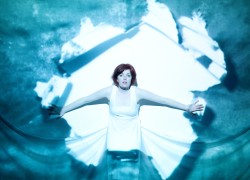
Fifty minutes is all it takes for Insomnia Cat Came to Stay to draw you into a world where time cannot be measured: the world of the sleepless. However, despite the constant agony of the condition, you find yourself entertained, enthralled, and even grateful to be exposed to the mind of an insomniac in such a breath-taking and cerebral manner.
Insomnia Cat is not simply a play about insomnia, either stylistically or thematically. It is a powerful blend of poetry, performance, music and animation that offers insight into the restless human condition. It is a one-woman show, but it would not have been as poignant, or even possible, without the perfect contributions of its offstage team. Writer Fleur Kilpatrick has shaped her own experience with the condition into what is not merely a stream of consciousness, but a flood. Her words never deviate from the insomniac’s unattainable obsession with sleep, as it comes to encompass all of life. Whether they take the form of sardonic references to pop-culture, considerations of neuroscience, or fevered, hallucinatory reminiscences, the crazed thoughts build with moving rhythm to crescendos of screaming or song, before sudden silences.
It would take a stellar performer to do justice to all the poetry and pain of the piece, and Joanna Sutton is just that. She is haunting from the start. Draped all in white, bound to the stage by the sleepless sheets that are her prison, she embodies a very human struggle with the unattainable. Her spoken, sometimes shouted delivery is hilarious in places, and always deeply moving. Her singing is powerful (she is a graduate of the Elder School of Music’s classical singing program), but unashamed to break with the strain of her character’s suffering. However, perhaps the most powerful element of her performance is her physicality. She is tied to one spot on centre stage and has her character struggle against this binding with the ferocious intensity of the unjustly incarcerated. With only the use of her upper body and her voice, she gives a performance to rival a full ensemble.
Set designer Sarah Walker ensures that the Sutton must fight so as to avoid disappearing into the set in the same way that an insomniac must constantly fight to avoid disappearing into sleepless oblivion. It is a simple set – Sutton in white bound by a white sheet, before a white projector screen – but it is aesthetically pleasing and thematically crucial. The simplicity of the set also allows animator Thomas Russel to superimpose the insomniac’s visions onto the insomniac herself. His lo-fi animations are what truly make Insomnia Cat a brilliant multimedia show. The hallucinogenic visuals emphasise the words and actions of the insomniac. Like the set design, the animations are simple but work with the other elements of the piece in an intricate and powerful way.
The music is the final element of the intense multimedia piece that is Insomnia Cat. Sutton sings lyrics by such notables as Tom Waits and the Rolling Stones. Her vocals are backed by a soundtrack composed and arranged by Roderick Cairns and mixed by Steven J Hearne. These guitar-driven arrangements capture a similar desolation to that in the work of the Velvet Underground, albeit in a more polished way. In fact, the show as a whole is comparable to Andy Warhol’s Exploding Plastic Inevitable. It is an assault of media on a cerebral level capturing the rapture of restless minds. In this sense, and in its own right, the soundtrack fits perfectly.
Director Danny Delahunty and his team can be extremely proud of the skilful combination of media that is Insomnia Cat. Every part works together to convey, ultimately, a beautiful chaos. Though credit must go to the team, it is still a one-woman show. Tuxedo Cat’s blue room is the perfect venue for it, the limited seating capacity adding to the intimacy already inherent in such a piece, and making Insomnia Cat Came to Stay a very personal, very intense experience.
Insomnia Cat Came to Stay is on every night at 9.45, until the 3rd of March, at the blue room – Tuxedo Cat.

